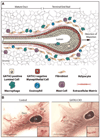GATA3 in development and cancer differentiation: cells GATA have it!
- PMID: 19798694
- PMCID: PMC2915440
- DOI: 10.1002/jcp.21943
GATA3 in development and cancer differentiation: cells GATA have it!
Abstract
There is increasing evidence that the numerous mechanisms that regulate cell differentiation during normal development are also involved in tumorigenesis. In breast cancer, differentiation markers expressed by the primary tumor are routinely profiled to guide clinical decisions. Indeed, numerous studies have shown that the differentiation profile correlates with the metastatic potential of tumors. The transcription factor GATA3 has emerged recently as a strong predictor of clinical outcome in human luminal breast cancer. In the mammary gland, GATA3 is required for luminal epithelial cell differentiation and commitment, and its expression is progressively lost during luminal breast cancer progression as cancer cells acquire a stem cell-like phenotype. Importantly, expression of GATA3 in GATA3-negative, undifferentiated breast carcinoma cells is sufficient to induce tumor differentiation and inhibits tumor dissemination in a mouse model. These findings demonstrate the exquisite ability of a differentiation factor to affect malignant properties, and raise the possibility that GATA3 or its downstream genes could be used in treating luminal breast cancer. This review highlights our recent understanding of GATA3 in both normal mammary development and tumor differentiation.
Figures



References
-
- Ansel KM, Djuretic I, Tanasa B, Rao A. Regulation of Th2 differentiation and Il4 locus accessibility. Annu Rev Immunol. 2006;24:607–656. - PubMed
-
- Asselin-Labat ML, Sutherland KD, Barker H, Thomas R, Shackleton M, Forrest NC, Hartley L, Robb L, Grosveld FG, van derWees J, Lindeman GJ, Visvader JE. Gata-3 is an essential regulator of mammary-gland morphogenesis and luminal-cell differentiation. Nat Cell Biol. 2007;9:201–209. - PubMed
-
- Avni O, Lee D, Macian F, Szabo SJ, Glimcher LH, Rao A. T(H) cell differentiation is accompanied by dynamic changes in histone acetylation of cytokine genes. Nat Immunol. 2002;3:643–651. - PubMed
Publication types
MeSH terms
Substances
Grants and funding
LinkOut - more resources
Full Text Sources
Other Literature Sources
Medical

